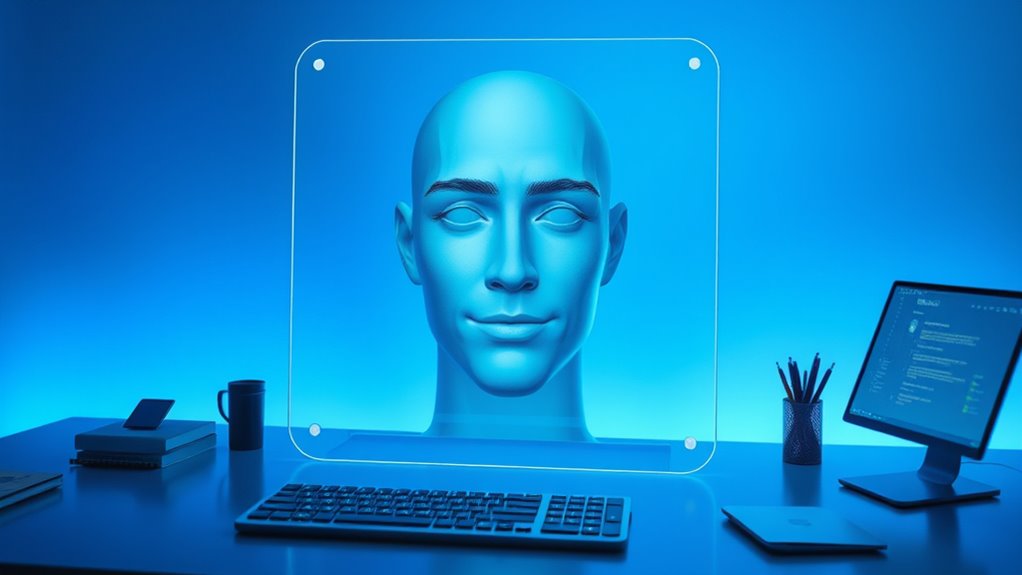Modern AI tools are challenging old myths by mastering subtle human expressions like emotions, tone, and physiological cues. They analyze facial movements, vocal patterns, and physiological signals to better understand feelings and intentions, making interactions more authentic and empathetic. These advancements show AI’s growing ability to grasp complex human nuances, moving beyond basic tasks. If you stay tuned, you’ll discover how these breakthroughs continue to reshape our understanding of AI’s potential.
Key Takeaways
- AI enhances authentic human expression by supporting memory, emotional recall, and inclusive communication for diverse users.
- Advances in Emotion AI enable machines to interpret subtle facial, vocal, and physiological cues accurately.
- Modern AI models demonstrate complex reasoning, facilitating more nuanced and empathetic interactions.
- AI tools challenge myths that technology erodes genuine connection, fostering deeper, meaningful engagement.
- Progress in emotion recognition and decision-making showcases AI’s ability to master subtle human cues authentically.

Are AI tools really eroding authentic human expression, or are they reshaping it in surprising ways? It might seem like these technologies threaten genuine connection, but the reality is more nuanced. AI now enhances your ability to remember personal details, fostering consistent care in relationships. Instead of replacing your natural memory, it supports you in recalling past emotional interactions, helping you communicate more thoughtfully. For people facing communication challenges—whether neurodiverse or with language barriers—AI tools democratize self-expression, giving everyone a voice. These tools broaden inclusivity, amplifying authentic perspectives that might otherwise go unheard. Interestingly, authenticity isn’t just about spontaneous expression anymore; it’s evolving into sustained, meaningful engagement over time, often facilitated by AI.
AI supports authentic human expression by enhancing memory, inclusivity, and meaningful engagement over time.
Advances in Emotion AI are key here. They analyze facial expressions, vocal tones, and physiological signals to decode how you’re truly feeling. For example, GPT-4.1 achieved 63% accuracy in recognizing emotions from facial images, outperforming other models. Commercial tools like RightFlow track emotions in real time alongside demographic and behavioral data, helping businesses understand customers’ subtle feelings. This progress enables AI to enhance customer experiences by detecting nuanced emotional responses to products and environments, making interactions more human-like and empathetic. Additionally, ongoing research into AI vulnerabilities highlights the importance of developing robust safety measures to ensure trustworthy deployment.
Modern AI models like GPT-4 can reason at a high level, surpassing earlier versions. They perform complex tasks, such as passing professional exams with top scores, showing they understand context and subtlety. These reasoning skills support decision-making and goal-driven planning, transforming AI into a collaborative thought partner rather than just a data repository. This evolution empowers you to make more informed choices and engage with AI in a way that feels genuinely human.
AI’s widespread adoption is also empowering and inclusive. It’s estimated that 72% of businesses use AI, contributing considerably to economic growth. When paired with ethical policies, AI becomes a tool for human empowerment, especially for smaller entities and underserved populations. While skepticism about AI authenticity persists—many worry it could undermine creativity and meaningful relationships—most prefer AI for objective tasks like medical diagnoses or weather predictions. Clear markers to distinguish AI-generated content are desired, as trust in detecting AI remains low. Still, AI tools are breaking barriers, enabling richer, more authentic human expression in ways that challenge old myths and open new possibilities.
Frequently Asked Questions
How Do AI Tools Interpret Complex Emotional Nuances?
You see, AI tools interpret complex emotional nuances by analyzing multiple cues like facial micro-expressions, vocal patterns, and textual context. They track subtle muscle movements, speech rhythms, and word choices to identify emotions beyond basic categories. By combining these signals through deep learning and multimodal approaches, AI recognizes intricate feelings such as contempt or pride with high accuracy, adapting to diverse situations and providing a deeper understanding of human emotional states.
Can AI Accurately Detect Sarcasm or Irony in Conversations?
You might think AI can’t detect sarcasm, but recent models like RoBERTa and GPT-4 are changing that. For example, an AI analyzing social media comments can identify sarcastic remarks with over 90% accuracy by incorporating context, multimedia cues, and advanced techniques like LSTM. While challenges remain, these tools now understand subtle cues better, making sarcastic detection more reliable than ever before—almost on par with human perception.
What Ethical Considerations Arise With AI Understanding Human Subtlety?
When AI understands human subtlety, you need to ensure privacy and consent carefully. You must consider users know how their emotional data is collected and used, protecting it from misuse. Be aware of biases that could unfairly target or discriminate against certain groups. Transparency is key—users should understand how decisions are made. Avoid manipulative or harmful applications, especially in sensitive areas, by maintaining ethical standards and human oversight.
How Do AI Tools Adapt to Cultural Differences in Expression?
You can see AI tools adapt to cultural differences by training on diverse datasets that include multiple cultures, enabling the models to recognize both universal and culture-specific expressions. They use techniques like adaptive learning and residual adapters to refine understanding continuously. By incorporating varied visual inputs and mimicking cross-cultural interactions, these tools improve their sensitivity and accuracy, helping them interpret subtle emotions across different cultural contexts more effectively.
Are AI Interpretations of Emotion Always Reliable or Context-Dependent?
AI interpretations of emotion aren’t always reliable because they depend heavily on context. Factors like lighting, cultural differences, and situational cues can influence accuracy. You should know that while advanced algorithms improve detection, bias and environmental conditions still pose challenges. For better results, AI systems that combine multiple cues, like facial expressions and vocal tone, tend to be more accurate, but you should always interpret AI insights cautiously.
Conclusion
You see how modern AI tools are breaking old myths by mastering subtle human expression. They’re redefining what machines can do, transforming how we communicate, understand, and connect. They challenge assumptions, push boundaries, and inspire innovation. As you embrace these advancements, remember that they’re not just tools—they’re catalysts for change, creators of new possibilities, and partners in progress. Stay curious, stay open, and watch how AI reshapes your world, one subtle gesture at a time.











